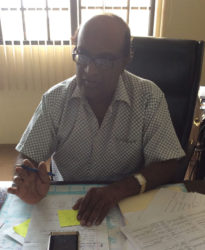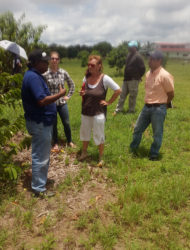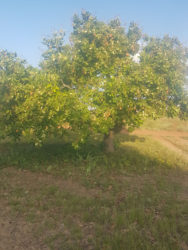Up until now hinterland development may not have featured nearly sufficiently on the agenda of government’s priorities in Guyana, but according to Chief Executive Officer (CEO) of the National Agricul-tural Research and Extension Institute (NAREI) Udho Homenauth, force of circumstances could compel a drastic change in policy direction.
According to one of the country’s leading agricultural specialists, climate change and its attendant consequences are making a compelling case for the relocation of commercial agriculture in the hinterland. Homenauth is adamant that the vulnerability of coastal lands to flooding means that planning the strategic development of the country’s agricultural sector in the period ahead must take into account the potential of the sprawling savannah lands of the interior to produce more food.

It is an initiative that will require the application of science since in order to farming in the savannahs, water will have to be harvested from vast areas of swamp, an exercise which, according to Homenauth, is already being achieved in parts of the interior. He named the JR Ranch in Region Nine as being among farming initiatives already harvesting water from swamps and said that the results of these initiatives suggest that they are sustainable. Rice is already being cultivated at the Santa Fe mega farm, using water from the Ireng River and cultivators of crops like vegetables, cassava and peanuts are already taking seriously the potential for large scale mechanized farming on Savannah lands utilizing water from swampy areas.
In pursuit of the realization of successful water harvesting to support farming in the savannah lands, Homenauth said, efforts are being made to strengthen ties with EMBRAPA (Empresa Brasileira de Pesquisa Agropecuária) a state-run research organization that seeks to develop technologies, knowledge and technical-scientific information aimed at providing sustainable solutions to challenges in the Brazilian agricultural sector. Homenauth said the work of EMBRAPA in the state of Roraima can serve as a template for agricultural initiatives underway at Wowetta and Moco Moco.

However, tradition and old habits die hard and there is already an official awareness that the threat of an eventual hostile environmental intervention will probably not be enough to encourage a wholescale shift from coastal to hinterland agriculture. Homenauth thinks that eventually good sense will prevail. Meanwhile, some initiatives are underway to encourage more private sector interest in interior farming, like the 20,000-acre model farm to be set up with funding from the Inter-American Development Bank at Pirari in the Rupununi as part of a wider Centre for Excellence for farming. Homenauth said that leaving aside its pursuit of water harvesting from swamp it will serve as a model facility for experimental agriculture, pursuing cattle rearing and cultivation of crops that will include corn, soya bean and rice.
One eagerly anticipated outcome of Guyana’s accelerated emphasis on savannah farming will be the development of a regime of closer cooperation in agriculture between Guyana and Brazil. Homenauth sees possibilities of an aggressive activation of existing Partial Scope Agreements between Guyana and Brazil that could extend bilateral cooperation between the two countries beyond the collaboration envisaged with EMBRAPA and into areas that could include the creation of abattoirs and food processing plants. These, he envisages, could fit into a broader paradigm linked to an accelerated emphasis of agricultural produce to Brazil, a move that would help alleviate the longstanding problems associated with the movement of food produced in areas of Guyana’s hinterland to the coast.

With the move towards the expansion of hinterland agriculture, Homenauth also sees possibilities in the business sector. The availability of large expanses of land in areas like Pirari and Ebini could see the cultivation of larger acreages of crops like corn and soya bean as well as for the consolidation of a regime of orchard crops including citrus and avocado. Fruit and vegetable processing prospects and the emergence of the need to move large volumes of food by road will also give rise to business opportunities arising out of the need for containerized transport.
It is, too, an opportunity for NAREI to play an even more central role in consolidating Guyana’s agricultural profile, contributing through new initiatives in farming science as well as opportunities for advancement in areas such as training and knowledge-sharing with institutions in neighbouring Brazil.
Disclosures by the NAREI CEO on the acceleration of state focus on hinterland agriculture follows disclosure by government in February of a planned US$10 million investment under an initiative known as the Hinterland Environmental Sustainable Developmental Project to be financed in the main by the International Fund for Agricultural Development. This project, State Minister Joseph Harmon had said, “will provide for the development of investment plans for the establishment of local value chains, the establishment of an investment fund for farmers and the execution of a food and agriculture study in Region One (Barima-Waini). A government news release had also said that the project was expected to benefit more than 80 indigenous communities.




